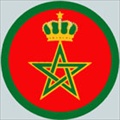
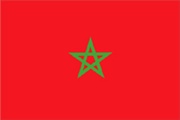 Credit: Roundels of the world
Credit: Roundels of the worldRoundel Fin flash

 Credit: Roundels of the world
Credit: Roundels of the world
Roundel
Fin flash
Last update 26-07-22
BASES
PROCUREMENT

Morocco received
shortly after its independence 12 Mikoyan-Gurevitch MiG-17 and 2 MiG-15UTI from the Soviet Union to equip its only fighter Squadron; these
were grounded
in 1963 following a border conflict with Algeria and Soviet
Union's preferencefor Algeria as an allied, supplying MiG-17, MiG-21 fighters and Il-28
bombers.
The USA were contacted in order to obtain new fighters; on 26-01-66 an arrangement was approved for 8 MAP supplied F-5A (USD 5m) and 2 F-5A, 2 F-5B and
support equipment supplied under credit (USD 6m) to equip one Squadron
based at Meknčs-Kénitra AB.
First 6 of 15 pilots completed their conversion at
Williams AFB in in May 1966; handover in USA of the first 2
single- and 2 double-seaters took place on 27-10-66;
AIM-9B Sidewinders were also supplied. A
USAF Military Assistance and Advisory Group was also stationed at
Meknčs.
Delivery
was originally planned to be completed in 1966, but by 1967
only the first three (four according some sources) single-seaters, followed in 1968 by
another five had been received. One double-seater was received in 1968. Different is the USAF Historical Office: four Northrop F-5A/B were operational in
September 1966, a fifth in June 1967.
According
to an official US list funded from the Security Assistance Program were FY
1976 (and previously) for 1 Northrop RF-5A, 2 F-5A, 7 F-5B.
Additional to the first lot of 12 aircrafts, 6 new Northrop F-5A, 1 former
USAF F-5A, 2 RF-5A reconnaissance aircrafts and 2 additional Northrop F-5B followed till 1971. Iran supplied six Northrop F-5A, authorisation
given by the US in April 1976, upon its own re-equipped with Northrop F-5E. Some single-seaters were received, according to one other source 5
Northrop F-5A and 2 reconnaissance Northrop RF-5A, were received
from
Iran.
Initial aircrafts were in natural metal colours kept till ca 1973, followed by late deliveries in camouflaged colours. Conversion traininig of F-5A pilots took during mid-70s also place in Iran.
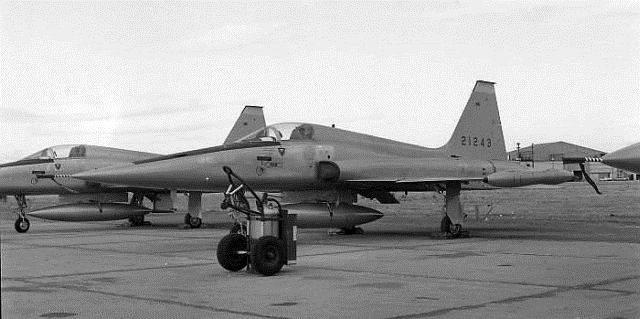
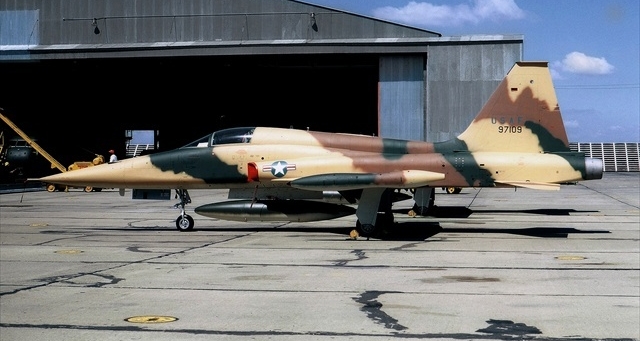
Northrop F-5A-35 21243 stored at McClellan AFB on 28-10-87 before handing over.
Northrop
F-5A-45 97109 seen in USA on 10-06-70, before delivery Photo: Frank
MacSorley
On
16-08-72 an event took place that was to influence the development
of F-5 operations for a long time: three armed, of the five
Northrop F-5As and 1 Northrop F-5B escorting King Hassan II on its return
from a
visit to France, attacked
the royal Boeing 727. The
King was not hit and the damaged Boeing landed at Rabat where the airport was strafed by the same aircrafts; one was lost, due to fuel shortage, when the pilot
tried to escape. Later that day, 4 F-5As strafed the Royal Palace, again without results. Hussan II was not hurt and a massive purge of Air Force personnel/pilots followed.
Freedom Fighters participated to the
six day war between Egypt and Israel in October 1973;
only a reduced number of pilots/aircrafts were available following the
recent coup against the King. On 19-10-73 twelve
Northrop F-5A and 14
pilots was transferred to the Egyptian base of el-Tanta via
Ageria, Tunisia and Libya. Two Lockheed C-130 delivered spare
parts, armament and technical personnell.
They participated only
to air
patrols behind the war lines. Two AIM-9B Sidewinder armed
Northrop F-5A had the only opportunity to engage the Israelis in
January 1974 when they were ordered to intercept 2 Mirage IIIRJ over
the Suez Canal area
but had to return to base when 4 Israeli McDonnel
F-4 protecting the reconnaissance aircrafts were discovered by the
radars.
First loss of Freedom Fighters occurred on 17-11-76 during the Indipendence Day parade at Marrakech, when one F-5A and one F-5B collided in flight killing three pilots.
SAHARA WAR
War
in former Spanish Sahara broke in 1974 out, when Spain was ready
to leave its colony. Morocco occupied two thirds (Northernregion) and Mauritania one third (Southern region, around Dakhla) of the country;
ocal Polisario Liberation Front, with the help of Algeria, continued its fight for independence after having started fighting against Spain since May 1973.
Fouga Magisters (based at Laayoune) and North American T-6 (based
at Ad Dhakla) were initially used for ground forces support,
but these were insufficent to combat the heavily armed Front
and Northrop F-5A were
used from 1976;
several aircrafts (probably most of the Squadron) were
deployed to Laayoune (formerly El Aiun) to shorten the enormous distance to the operation field; initial
Moroccan main objective was to
create a controlled/safe area around
Laayoune, Smara and the phosphate rich field of Bu Craa. At least five Northrop F-5A were stationed at Laayoune in 1978.
An offer for 20 Northrop F-5E and 4
F-5F Tiger was requested in August 1975 by the
Moroccan government to strengthen the ground-attack/air defence
capability and a Letter of Offer and Acceptance for the value of
USD 120m was submitted by the
USA in March 1976; this included training, support equipment and
spares, all to be paid by Foreign Military Sales credits.
Deliveries could have started in 1977.The offer was not taken-up
as
was a second Letter of Offer the same year. Morocco requested at this point
the supply of Tigers under the US Military Assistance Plan, which was denied by the USA.
An
order was instead placed in 1975 for 30 Dassault Mirage F1.CH (interceptors
with ground attack capability), followed by additional 14 Mirrage F.1EH
and 6 Mirage
F.1EH-2000 (fighter-bombers). Deliveries started in
February
1978, ending in 1980; these aircrafts became the main ground attack aircrafts.
A possible swap of Jordanian Northrop F-5As against Moroccan bought Northrop F-5E considered in 1976 took not place.
Polisario
introduced in its arsenal the SA-7 Strela short-range, shoulder mounted, surface-to-air missile in
1976 to contrast Moroccan fighter-bombers, succeeding in shooting down one F-5 already on 21-01-76.
During
1977 and 1978 Freedom Fighters were used in a limited extent; they
flew only an average of 100 hours a month.
On
12-12-78 Moroccan AF F-5As and North American T-6s attacked an
Polisario column heading to attack the Mauritanian railway line.
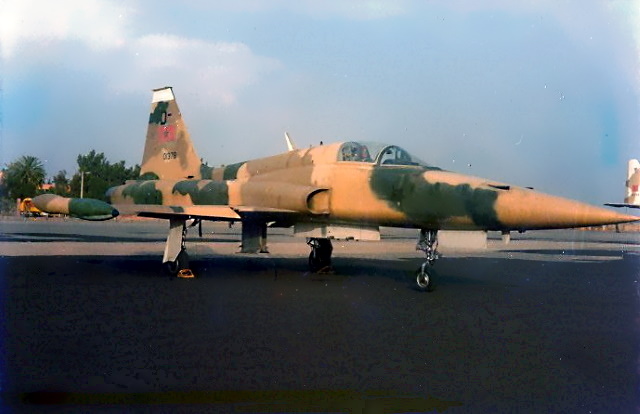 Photo : via www.farmaroc.com
Photo : via www.farmaroc.com
Former Iranian Northrop F-5A 01378; of note Iranian code "O" on tail
Use of Freedom Fighters in the Sahara region posed a problem as early
USA armament use was limited by the US Arms Control Act; this
authorsed the use of the weapons only for internal security and
self-defence.
During a US congressional hearing in March 1978. the State Department
stated that their use was not a "substantial violation" of US law.
Battle area size increased considerably in July
1978, when Mauretania arranged a ceasefire and Morocco occupied its former Western Sahara area; in Mauritania
stationed Moroccan troops were withdrawn when a peace
agreement was signed in August 1979, when (most probably all) Northrop F-5s
were also withdrawn.
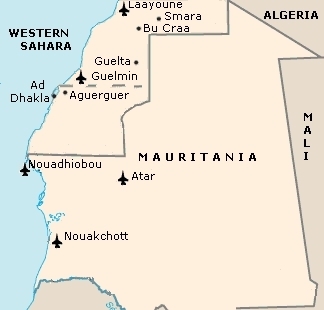
Freedom Fighter bore the brunt of the aerial combat, flying numerous strikes against Polisario targets. The Mauritanian Army, relatively poorly equipped, needed help;
three F-5As were also based at Nouadhibou (Mauritania) to support
it. Other airfields, Nouakchott and Atar, were expanded
to accomodate Moroccan F-5s and
Mirage F.1 beginning 1978. At least five Northrop F-5s were based at Laayouine in February 1978.
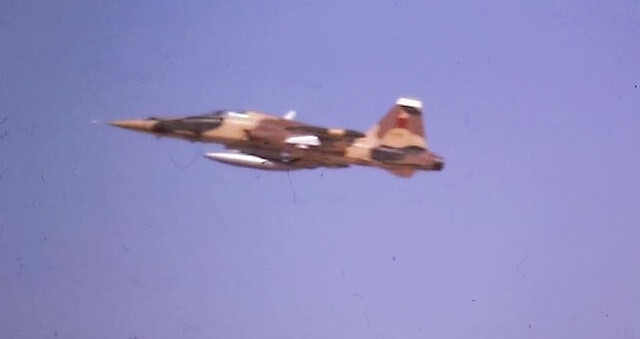 Photo : via www.farmaroc.com
Photo : via www.farmaroc.com
Unknown Northrop F-5A Freedom Tiger on take-off at Nouadhibou in
February 1978
Altogether 9 Northrop F-5 Freedom Fighters were lost during the war.
Finally,
after approval in October 1979 by the US government and with the finacial help of Saudi Arabia, 16 Northop F-5E an 4
Northrop F-5F were
ordered late 1979 at a cost of ca USD 170m; this was part of
a USD 253m package which included 6
North American OV-10A and 24 Hughes 500MD. Another 6 single-seaters ordered by Morocco were not taken-up and transferred to Singapore.
In flight delivery via Canada, Greenland, Iceland and the United Kingdom of the
first 10 F-5E and 4 F-5F started in January and was completed by
August
1981. The remaining 6 Northrop F-5E, the first built aircrafts
and in-flight
refuelling probe equipped, followed in January 1983. The local aviation industry installed the probe on the remaining aircrafts in Morocco.
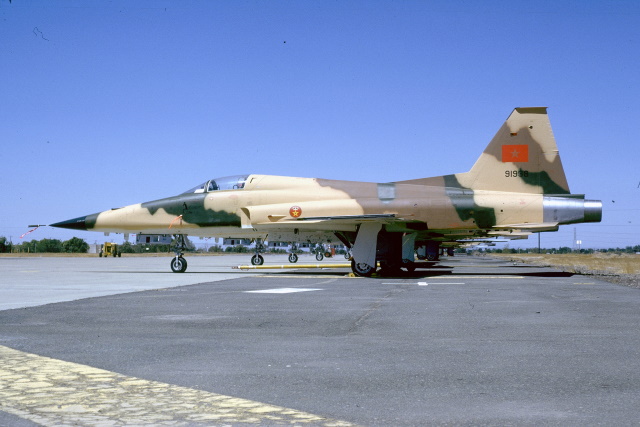
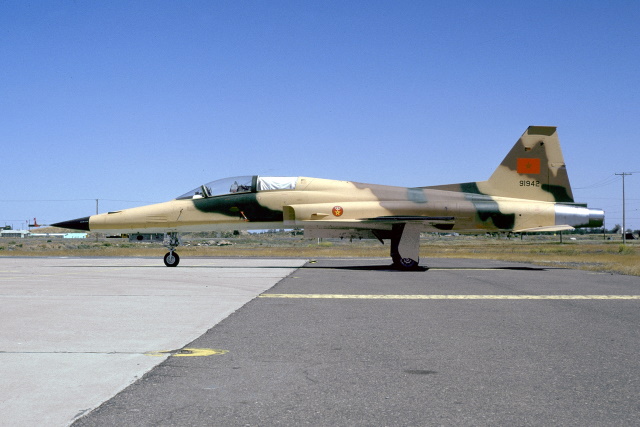
Awaiting delivery in USA
91936, of note missing ECM antenna/air refuelling probe.
Northrop F-5F 91942 in USA before delivery May 1980, no ECM atenna/air refuelling probe.
Photo : Archive The Northrop F-5 Enthusiast
Acquisition of 381 AGM-65B Maverick ground-attack missiles, for use by both the F-5
and Mirage F.1, was decided
in order to avoid to be exposed to anti-aircrafts guns and missiles;
a
contract was signed in April 1982. For air-to-air combat AIM-9B
Sidewinders had been originally purchased, followed later by more
advanced AIM-9D and AIM-9J versions, later AIM-9M.
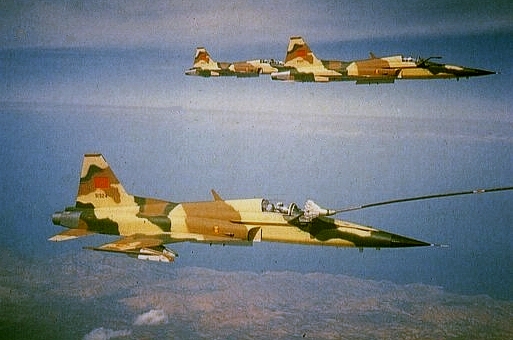
Aero
Maroc Industrie was established 10-81 at Casablanca to support,
overhaul, modify and repair Moroccan military aircrafts,
including FreedomFighters
and Tigers.
To
help alleviate the F-5 short range problem of the aircraft,
insufficent to operate deep iinto the desert,Aero Maroc Industrie
fitted a Northrop F-5B ca 1982 with an in-flight
refuelling probe as a prototype installation for operational trials with a newly bought
Boeing B.707-138B fitted with Beech
hose units at the wingtips for refuelling of Northrop F-5E; 2
Lockheed KC-130H were also
delivered beginning 1982.
Photo: unknown
The Hares photo reconnaissance pod for Northrop F-5E and GAMD Mirage F.1s was also produced by Aero Maroc Industrie.
2 Mirage F.1
and 1 C-130 near Guelta Zemmour and to the reduction of
operation for these fighters, leaving the
Army with little or no air support and reconnaissance for the period between October and
December 1981.The loss of 1 Northrop F-5A and Mirage F.1with their
pilots was devastating, resulting a ralation crises between the Army
and Air Force.
the air arm went on a very limited offensive
starting from January 1982; it could still operate from EL Ayoun with 3 Mirage F.1 and 2 Northrop
F-5, though no pre-or past strike reconnaissance took place.
An
October 1986 (but probably prepared around 1983) USA published in-depth
study of the Moroccan AF stated that there were 8 Northrop F-5A/F-5B serviceable and 12 qualified pilots, but were rarely flown.
Thirteen
Northrop F-5E/F-5F were also available without any radars warning
system, chaff flare dispensers; only 6 pilots were qualified to fly
this model. All aircrafts were minimally used in the war zone; six
additional RWR equipped were on
order.
Pilots
needed around three years to achieve initial operational capability on
the Northrop F-5s, too long for western standards and the main air war limiting factor was the shortage of pilots, those
available were
not trained to fly in an SA-6 missiles environement. The
best F-5 pilots were transferred to the Mirage F.1 units used in the
fighter-bomber role, aircrafts having some counter-electronic measures
equipment.
Two
Dassault Falcon 20 and 1 Falcon 50 were modified with Electronic Counter
Measures (jamming) equipment to partially make good lack of equipment on thr
fighters.
USA assistance to solve the SA-6 problem was requested and granted in 1987. A three-men USAF team went for 60 days
to Meknčs to teach to the pilots on low-level, high-speed flying skills. Unfortunately the
team's results were not very effective for several reasons.
In addtion, the USA offered 10
ALQ-119 ECM pod and 10 ALE-38 chaff and flare dispensers at a cost of between USD 20m and USD 40m on
a cash, non-renewable lease basis, which was not accepted due to
the
high costs and the short time pods' availability
Sexteen serials of new built Northrop F-5Es and of four F-5F are known.
Finally, on
11-08-88 Morocco and Polisario agreed upon a UN cease fire plan but it
went in effect only in 1991, though war actions slowed down during
this
period, but dragged on till now.
War Losses: Dates written in blue are claimed by Polisario
F-5A
18-02-78 over
Aguerguer, 08-06-78 (two), 10-09-78 North of Smara by SA-7
missile, 10-02-79 serial 669120, -10-79, 27-12-80, 13-11-81 during the battle for Guelta Zemmour.
F-5E
12-01-85 by SA-6 near Algerian border, 21-08-87, -09-91 near Tifariti serial 91921.
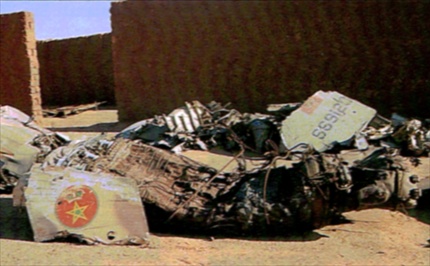
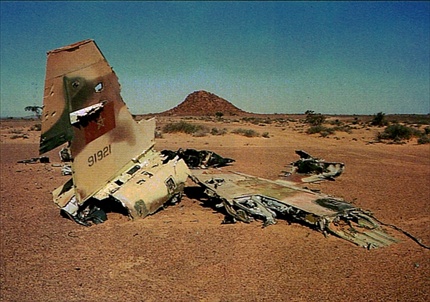
Overhauls, modifications, upgrades
The 1990's were used to overhaul, modify, upgrade and to top-up the remaining fighters . Unfortunately no detailed official information is available.
Eleven Northrop F-5Es, formerly operated by USAF's disbanded 527th
Squadron for dissimilar training in Europe, were bought to make good
losses. Deliveries from Kemble AB (UK) started on 19-10-89, being
completed on 08-04-92. These aircrafts had been heavily used and had
limited avionics equipment; they maintained initially their original colours. Seven are known to be equipped with tail Radar Warning Receiver
equipment.
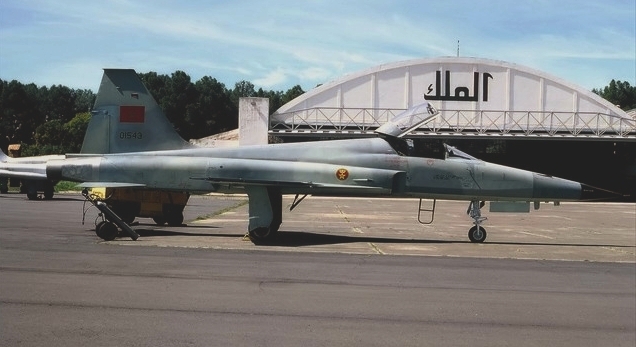
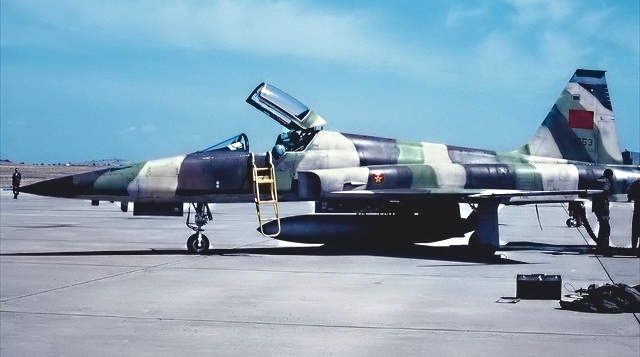
Northrop F-5E 01543 at Meknes in July 1990 in USAF camouflage, in the background a
Northrop F-5E
01553 in aggressor camouflage in 1991.
Freedom Fighter in silver colours!
Photos: Archive The Northrop F-5 Enthusiast
Planned
partial replacement of the Tigers in 1991 with 12 former US Air
National Guard General Dynamics F-16A and F-16B, again financed by
Saudi Arabia, was not realised due to Saudi funds shortage after the
first
Gulf War.
Improvements to Freedom Fighters were realised with the installation of Northrop F-5E avionics on the remaining aircrafts (probably
8 F-5A 2 RF-5A, 2 F-5B); a contract was stipulated with the French
company
Sogerma at Bordeaux (France) and protoype installations were carried out
on an Northrop F-5B, re-delivered in October 1997, and one Northrop
F-5A, re-delivered in February 1998. Five Northrop F-5A
had been
modified in Morocco by April 1998.
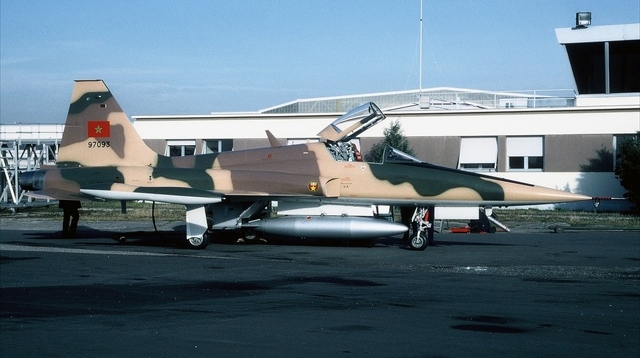
Upgrade prototype Northrop F-5A-45 97093 at Bordeaux in February 1998,
Photo: Archive The Northrop F-5 Enthusiast
Next step to keep the fleet up-to-date concerned the Northrop F-5E/Fs; details are sketchy due to political sensibility. It seems that negotiations were already held with IAIof Israel around 1996 without follow up.
The year 2000 saw the start of actual planning and IAI was selected to do the work, though there is no official information; upgrade consisted in an EL/2032 multi-role radar, navigation, heads-up display and several
other equipment.
The
deal with IAI failed and Sogerma took-over the uprading , done between
2001 and 2004. Prototype conversion was possily carried out by SOGERMA
followed by other conversions at Casablanca; both original
Moroccan and some former USAF obtained
these modifications. Elettronica
ELT/555 active Electronic Countermeasures (ECM) pods were purchased in Italy, RWR, HOTAS system were installed, together with an
HUD;
additionally Northrop Grumman Litenining laser designator
pods have been purchased. All this gave an enormous improvement over the original Northrop F-5E/F-5Fs; new local designation is Northrop
F-5E III.
 Photo: BNAF
Photo: BNAF
Northrop F-5E 91940 equipped with ACES ECM pod photographed in flight.
There
were 32 aircrafts in service in 2004 according to an US source. Another
source mentioned that as few as 10 Northrop F-5 remained in service; 3
should be lost in combat (1985, 1987, 1991), up to 7
cannibalized at
Laayounne or Guelmin.
It is reported that some (7) Tigers have been cannibalised by the
beginning of 2014 for spare parts and 24 have been updated to the new
configuration;pPilots are current in air-to-air and to ground specialities.
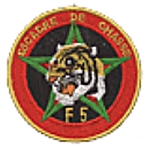
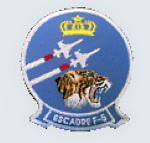 The Escadre (Wing) includes two Escadrons (Squadrons):
The Escadre (Wing) includes two Escadrons (Squadrons): 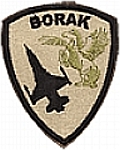 Escadron Borak - mainly for air defence duties, training on two-seaters
Escadron Borak - mainly for air defence duties, training on two-seaters 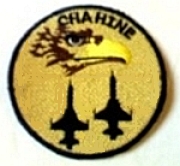 Escadron Chahine - mainly for air-to-ground duties
Escadron Chahine - mainly for air-to-ground duties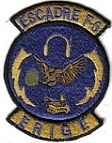 (Escadron de reconnaissance, d'Interception et de Guerre
Electronique/Reconnaissance, Interception, Electronic Warfare Squadron).
(Escadron de reconnaissance, d'Interception et de Guerre
Electronique/Reconnaissance, Interception, Electronic Warfare Squadron).
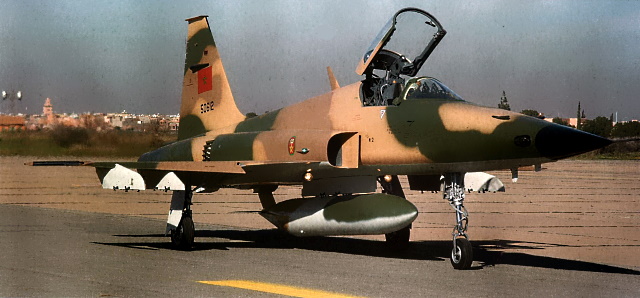 Photo: Archive
F-5 Enthusiast
Photo: Archive
F-5 Enthusiast
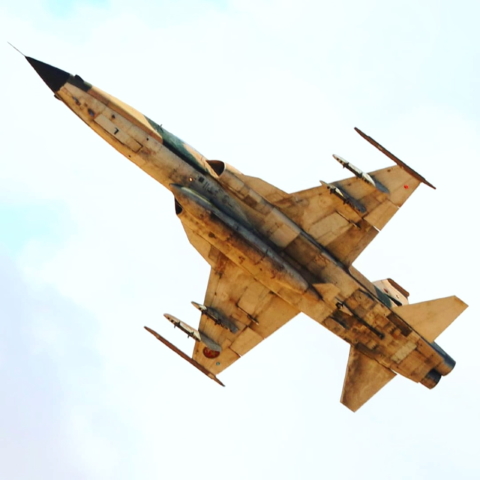 Photo: far-maroc.forumpro.fr
Photo: far-maroc.forumpro.fr
The
Air Force command was well aware or the importance of dissimilar
training, with
other Air Forces, for Moroccan Northrop F-5 and Mirage F.1 pilots;
this particularly in view of the re-equipment of the Algerian AF with
high performance fighters/bombers (MiG-23, MiG-29, MiG-25).
An important number of execises/exchanges was organised, both in
Morocco and abroad, even while the war was going on.
Regular yearly Moroccan/Spanish exercises, alternatively held in Morocco and Spain, were established under the names "Atlas" and "Navimaes", starting from 1984.
Two Northrop F-5B of the Spanish Escuela de Reactores deployed to Meknčs AB during 1984.
"Atlas-88"
took place mainly in the area of the Straight of Gibraltar on the 2nd
and 3rd 1988 with the particioation of Moroccan Northrop F-5.
GAMD Mirage F.1, Alpha Jet and French GAMD Mirage III, McDonnell
F-4C,
GAMD Mirage F.1
Four Northrop F-5E/F were deployed for "Atlas 1993" to Talavera la Real AB.
"Atlas-00'" was the deployment in March 2000 to Talavera la Real (Spain) of 3 Northrop F-5E and 1 F-5F.
The
2002 edition took place from the 7th till the 12th of April; three
Spanish CASA/Northrop SF-5 came to Meknes AB to mix with four local
four local Northrop F-5E, while four Spanish GAMD Mirage F.1 met with
five
local GAMD Mirage F.1.
French Base Nancy-Ochey was used for ECM training in May 2003: This base is particularly known housing radars hunting aircraft.
Five Northrop F-5E/F were deployed for "Atlas 2004" to Talavera la Real AB (in addition to Mirage F.1CH/EH and 5 Alpha Jets to Albacete AB. The Spanish AF participated to this years' exercise with F-5BM of Ala 23,
McDonnel F-18 of Ala 12, Mirage F.1 of Ala 14.
Two Northrop F-5E and 2 Northrop F-5F deployed to Talavera AB in order to exercise with the Spanish Ala 23 CASA/Northrop F-5B+s for exercise "Navimaes 06" between July 24th and eighth, 2006.
The 2008 edition of "Atlas" exercise started on May 26th; two
Northrop F-5E III and one F-5F III went to Talavera la Real,
their pilots coming from both Squadrons Chahine and Borak. These aircrafts operated with
and against CASA/Northrop F-5M, Dassault Mirage F.1 and McDonnell EF-18.
Talavera la Real AB was visited again for another edition when 4 Tigers took part to the exercise from November 21st till 25th 2011, while 4 Northrop F-5E (together with Mirage F.1s) went between the 4th and 8th
June 2012 to Talavera AB.
The 2012 edition took place again at Talavera la Real AB with X
Northrop F-5E (and Mirage F.1s) while the 2014 took place from Meknes
between June 9th and 13th. Moroccan Northrop F-5s and Mirage F.1
engaged
Spanish McDonnell F-18 normally based at las Palmas
AB.
Three Northrop F-5E and 1 Northrop F-5F deployed to Talavera AB in order to exercise with the Spanish Ala 23 CASA/Northrop F-5B+s for exercise "Navimaes 15" between thr 8th and the 12th June 2015.
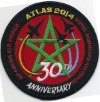
"Atlas 2016", 30th edition, started with 5 Northrop F-5E and 1
F-5F on 20-05-16 and ended at Salamanca, where the Ejercito del Aire
utilized 3 Northrop F-5B+ as well as CASA 101 and McDonnell-
Douglas A/F-18s of
Ala 12.
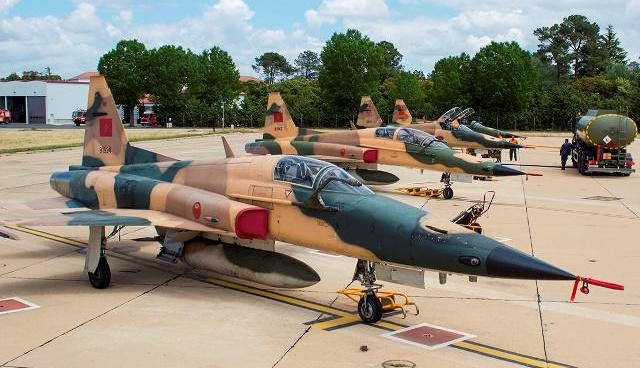 Photo: Archives Northrop F-5 Enthusiast
Photo: Archives Northrop F-5 Enthusiast
Three Northrop F-5E and 1 Northrop F-5F participating to the Atlas 2016 excercise at Salamanca AB
African Eagle" and "Ardent Eagle" exercises are held with USAF and US Marines units.
Collaboration
with the USAF started in 1986, when the 525th Fighter Squadron, USAF,
with its McDonnel F-15C was based at Sidi Slimane AB for one month in,
followed with a similar exercise in 1987.
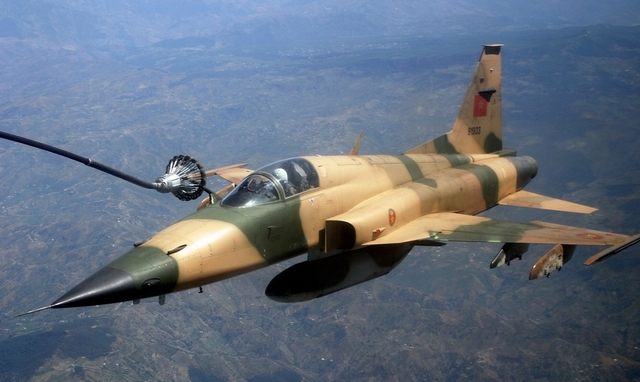 Photo: US Marines
Photo: US Marines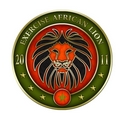
Deployments to France could not miss:
Two
Northrop F-5E and two F-5F, with their Elettronica ELT/555 pod were
hosted at Colmar AB (France) in June 2002, probably to test their
recent avionics/ECM upgrade.
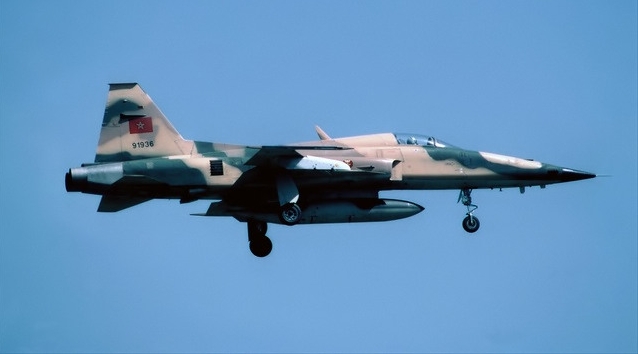
Northrop F-5E 91936
landing at Colmar AB in June 2002 without underwing ECM pods and no
air-refuelling
probe.
Photo: E Bannwarth
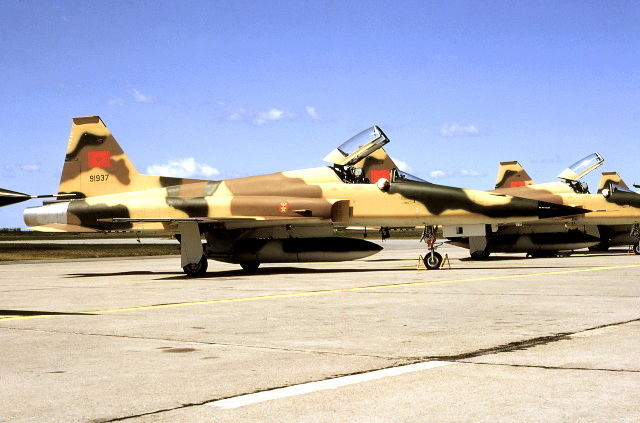 Photo: unknown
Photo: unknown
Line-up of Northrop F-5E, first serial 91937
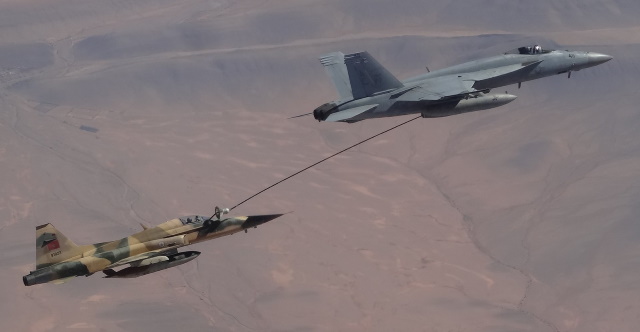 Photo: US Navy
Photo: US NavyModifications / Replacement
Upgraded Northrop F-5 remain in use with the Escadre de
Chasse 2 "Tiger" at Meknes/Bassatine AB, mainly as fighter-bomber
with AGM-65B missiles (from 1981) and possIbly AGM-65D/H.
Modifications
to the Northrop F-5 hardware include a new Elta EL-2032M radar,
this and modified software allow now the use of AIM-120C, AIM-9X y
AGM-65D missiles.
The
choice of a new, first-line was announced in June 2008 after a
long struggle between the Dassault Rafale and the Lockheed-Martin
F-16C/D Block 52; this last won the order for 16 single- and
8 double-seater
aircrafts.
The first 4 aircrafts were received in August 2011 and the last 3 on
22-08-12. Experienced Tiger pilots were trained at Tucson International Airport with the US National Guard. The F-16s have
now
equipped newly formed Escadrons.
In
November 2021 the Israeli Defence Minister visited Morocco. It signed
an agreement to modernise Moroccan F-5s, particularly avionics, done by
Elbist. It includes designation-pod Rafaeö Litening II and air-to-air
missiles Rafael Derby and infra-red Python 5, as well as intelligent bombs
Rafael Spice; all these improvements are similar to the ones already
done to the Brazilian and Thailand fleet in order to keep the
modernised
Tigers operational at least for 15 years. In addition to these improvements is
the purchase of Elbit Delilah short-range cruise missile. Morocco announced in April 2022 a deal with a Belgian contractor for launching an
uprade of its F-5 Tigers.
One
information state that there are in April 2022 approximately 23 Northrop
F-5E and 4 Northrop F-5F in two units at Meknes AB in use.